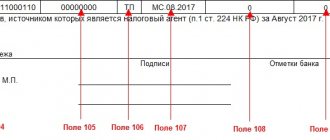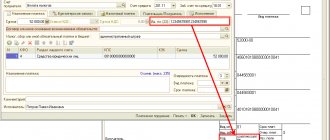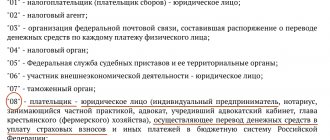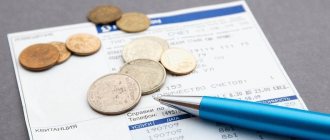Regardless of the purpose of the payment - state duty, fine or tax - banking institutions and terminals are required to fill out the UIN column. This detail helps the system automatically determine the payment and who it is intended for. For state duties, as for other types of payments, a personal identifier is provided, consisting of a unique digital set. If the payer does not know what a UIN is when paying state duty or does not have its exact meaning, we recommend checking the combination with the payee.
Unknown UIN for state duty
The abbreviation “UIN” means Unique Accrual Identifier. In the payment document, its value ranges from 20 to 25 digits and is entered in the “Code” column:
The main need for the identifier in question is among bank employees and Treasury employees. Knowing the exact code allows you to make a payment for its intended purpose without confusing it with another addressee and/or reason. This is where the name itself comes from - UIN. Since the combination of numbers is unique, it protects against errors when filling out a payment document and guarantees that funds are sent to their destination.
If the UIN for the state duty is unknown to the payer, the bank or terminal may not accept such a payment due to the lack of correctly entered data. There are several options for the development of events:
- Find out the identifier from the payee or a bank employee, if possible.
- Enter the number “0” (zero) in the “Code” column, on the basis of which the payment can be credited using other details - address, current account, BIC, etc.
- Leave the “Code” column empty (the riskiest choice).
If there is no effect from one of the listed actions, the payer can perform them all one by one until he gets the result. The best option is still to fill the column with the current identifier, since leaving it empty or with the value “zero”:
- the payment may be mistakenly transferred to another organization;
- will be rejected altogether.
Also see “Procedure for generating UIN for payment orders”.
Payment document identifier GIS Housing and Communal Services
The GIS account of a payment document is a special code that contains information about the residential premises, consumer and type of utility service, as well as information about the payment document. The GIS account of a payment order consists of 18 characters, which have the following meaning:
The full payment document identifier (PD) is a special alphanumeric code that consists of 18 characters. This GIS account is entered into the document by the housing and communal services company so that the end consumer can pay for utilities using this GIS account. This code is useful both for paying utility bills at the bank and for paying online. The housing and communal services identifier in the Housing and Communal Services GIS contains information about the residential premises, the consumer, and so on. The code consists of 18 characters; The account itself can be divided into three main blocks:
We recommend reading: Article 219 of the Tax Code of the Russian Federation with amendments for 2021 with comments
Filling out the UIN in the receipt for payment of state duty
The legislation has not developed a specific classification of UIN, as well as a list of identifiers for organizations. This is why payers often have problems on this issue. Especially if you need to fill out a payment order for state duty.
First of all, it is necessary to check whether a unique identifier is indicated in the document that was issued/generated to the payer. If yes, then this is what needs to be indicated on the receipt.
If there is no UIN in its literal meaning, you should look for the “Document Index” column. In most cases, the number indicated in it will correspond to the UIN, which must be included in the payment for state duty.
The value of the “Document Index” is based on a similar principle as the identifier itself.
| Decoding the UIN code | |
| Number order | What does it mean |
| First 3 digits | Receipt Manager at the Treasury |
| Next single digit | Authority to whom the payment is addressed |
| One more number | Payment category (state duty) |
| Subsequent digits (except last) | Details of the document for payment |
| Last digit | Determines the uniqueness of the identifier |
Also see “Payment order for payment of state duty to the arbitration court: sample”.
How to pay a fine using your UIN number
In order to pay for any service, you must indicate the UIN number, consisting of 20 or 25 digits (it is indicated in the notice, receipt, or issued when ordering the service on one of the state portals) and click the “Search” button. If the specified accrual is found in the GIS GMP, then all the necessary details will be entered automatically.
Payment, for example, of a fine by UIN number online is available regardless of the region where the service is received and ordered or the accrual is paid. You can pay off debts or make any other payments throughout Russia, including in the following regions:
- Moscow and Moscow region,
- St. Petersburg and Leningrad region,
- Krasnodar region,
- Novosibirsk region,
- Ekaterinburg and Sverdlovsk region,
- Sevastopol and the Republic of Crimea.
Determination of UIN when paying state duty to the traffic police
Let us immediately note that the UIN when paying the state duty of the traffic police consists of 20 digits. To fill out the corresponding column, the payer must duplicate the identifier:
- from a receipt for payment of state duty;
- any other document provided by the traffic police.
If there is no information about a unique identifier, “0” should be entered in the corresponding column. This payment will go through like a regular one. The credit institution is obliged to accept it.
We do not recommend leaving the UIN field completely blank, because payment may not be completed due to such an error in filling out the document.
Please note that you absolutely cannot indicate a UIN that is intended for another type of payment. For example, a fine. In this case, payment of the state duty will not take place, and getting the funds back will be problematic.
Also see “UIN in payment orders: sample”.
Read also
01.01.2018
What can you pay using your UIN?
Payment by UIN is a simple and convenient tool for making payments for any state and municipal services. With the help of this service, paying debts, fines and various duties has become much easier and no longer requires even leaving home. With us you can make payments for services such as:
- fine for violating quarantine and disseminating false information about coronavirus;
- a fine for violations of the self-isolation regime and other violations of legislation in the field of ensuring the sanitary and epidemiological well-being of the population;
- administrative fines, in particular, for ticketless travel and traffic violations;
- fee for obtaining a civil and foreign passport from the State Administration for Migration Issues of the Ministry of Internal Affairs of the Russian Federation (formerly the Federal Migration Service);
- educational services - payment for kindergartens and schools, replenishment of personal accounts in various payment systems for passage and meals;
- state duties for the provision of hunting and fishing licenses, as well as permits for trading and other activities.
What to do if the UIP is indicated incorrectly
When the UIP is entered incorrectly on a payment slip, the bank is still obliged to fulfill the client’s payment order. The following cases are exceptions:
- when the accounts of the recipient and the payer are opened in the same bank;
- when the account to which the funds are transferred is opened for the purpose of identifying the payment.
In these situations, the bank of the obligated person, after checking all the details, will cancel the payment if there is no UIP in it.
If a payment order is executed but the code is entered incorrectly, a problem with payment identification may arise. And then the obligation to pay debts on taxes, contributions, as well as penalties and/or fines will be considered unfulfilled. The payer may need time to identify and clarify the payment. And this will lead to additional penalties.
Also see “Payment order at the request of the Federal Tax Service: details of filling out”.
Read also
02.12.2018
Methods and types of payments with UIN
Entrepreneurs and legal entities indicate the identifier in cases where the company was required by a government agency to make a payment. The requirements always contain a UIP or UIN for transferring it to the order form.
The requirements include the following types of payment:
- Insurance premiums. This area is controlled by the Federal Tax Service.
- Taxes and penalties.
- State duties.
- Penalties.
Various payment methods are allowed:
- Through the State Services website. The system automatically enters the UIP number. If the person filling in the 22nd column placed “0”, this action will not be regarded as an error.
- Through terminals. When using this option, the payer cannot specify the identifier, therefore it is allowed to replace it with “0”.
- Bank. Employees of a financial institution can return an order only if column 22 is empty. If “0” or id is entered there, the form will be accepted.
Difference between escrow and letter of credit
If receipts are generated for individuals, the required id can be specified in advance. Numbers are assigned to the following types of payment:
- it is necessary to obtain an extract from the state register;
- submitting a request for a certificate;
- payment of state duties;
- transferring money to pay traffic police fines;
- payments for administrative violations;
- payment for registration of real estate.
Expert opinion
Alexander Ivanovich
Financial expert
Important: if a request has been received that contains a UIP number, the numbers must be transferred to the order. If this is not done, the amount will not be counted and the issue will remain open.
Where and how to get a UIN to pay tax?
Accrual identifier is a code that the taxpayer cannot generate on his own, receive when filling out a receipt at the bank, or look up in a reference book. A logical question arises: where to get the UIN when transferring taxes? Logically, contact the nearest inspectorate.
Indeed, it is the Federal Tax Service that assigns unique numbers to tax payments, but only if it itself sends a notification of debt to an individual or legal entity. Having received the request, the taxpayer deposits the required amount using the index stamped on the tax notice when issuing a bank receipt. For this purpose, the “payment” contains field 22 “code”, where a unique digital combination of 20 characters is entered.
This is usually how individuals pay off their property taxes. In order to “pay and sleep in peace,” they wait for a mail notification from the Federal Tax Service or print out the necessary receipts through their personal account on the department’s website. Since these documents are generated by the budget recipient, the UIN is assigned to them automatically.
The situation is different with individual entrepreneurs and organizations. As a rule, they make tax payments based on their own calculations and declarations. The transfer of an amount calculated by the organization independently does not and cannot have a UIN. Such payments are identified using other details.
An exception is the repayment of debt owed to the budget by an individual entrepreneur or legal entity on the basis of a received tax notice. When sending a request to the debtor to transfer the arrears, pay penalties and fines, the Federal Tax Service assigns a UIN to the document.
When to specify a unique payment identifier
Cases when affixing the UIP code in a payment order is mandatory are listed in the aforementioned Regulation on the Rules of Money Transfers No. 383-P of the Bank of Russia. In accordance with this document, the UIP is included in the payment if it has already been assigned by the recipient of the funds. And the assignment of a UIP to a payment is possible in 2 cases:
- The identifier is assigned to the payment by the recipient of the funds, and he is obliged to provide this information to the payer in accordance with the agreement. In this case, the recipient’s bank, on the basis of a banking service agreement, can control the correctness of the reflection of the UIP in the order for the transfer of funds (for example, when paying for government services to the payer, including an individual, the UIP is reported to transfer funds).
- When an obligated person pays contributions to extra-budgetary funds and taxes on the basis of a demand for payment. The UIP code is reflected in the requirement and is required to be included in the payment order.
When transferring sums of money, the UIP is indicated on the payment slip only when it is known to the payer. If there is no information about this detail, then put “0” in field 22, since it is unacceptable to leave it blank. The bank will not accept payment orders with unfilled mandatory details.
For groups of taxpayers such as individual entrepreneurs, lawyers, notaries, farm managers, etc., there are some special features when filling out the details for 22 payments. When transferring funds to the budget in the payment order, they indicate:
- or your TIN in the “Payer TIN” field;
- or UIP in the “Code” field.
If the document contains a TIN, then a zero is entered in the “Code” detail. In such cases, banks do not have the right to require simultaneous completion of both details, as happens in some cases. Explanations on this issue are given in the letter of the Federal Tax Service No. ZN-4-1/6133 dated April 8, 2021.
Also see “UIN in payment orders: sample”.









